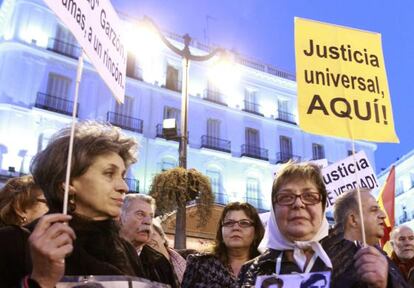"With Garzón gone, so has the chance for justice"
Experts in exhumation of Franco's victims can provide detailed post-mortem reports


Hundreds of people showed up in Madrid's Puerta del Sol Monday night demanding that the Supreme Court appoint a court to investigate Franco-era crimes. Supporters of disbarred High Court Judge Baltasar Garzón believe that now while the top court has now acquitted him of breaching his bench duties by trying to open up an inquiry in 2008, it has effectively buried any chance for an official probe.
The justices ruled that while the "search for truth" is "a legitimate and necessary one" it "doesn't correspond to a judge" but the state. Practically all judges - except in Granada and El Escorial - have dropped investigations into Franco-era assassinations.
The murder could have been committed yesterday or 75 years ago, but if the relatives of the victim are to come to terms with their loss they need to know something about the circumstances of the death: whether their loved one suffered; died alone; or what was the weapon used to kill them.
Forensic scientists working at the sites of extra-judicial killings carried out during the Civil War find themselves trying to answer the same questions from men and women now in their eighties and nineties who want to know which of the jumble of skeletons lying entangled and partially exposed at the bottom of a pit is their father, mother, wife or husband. They want to know whether they were killed after being thrown in or whether murdered somewhere else and taken there, and whether they were shot in the back of the neck, and so on.
Over the last decade some 300 mass graves have been opened up at sites throughout Spain where pathologists, archeologists and anthropologists have painstakingly exhumed the remains of more than 5,500 men and women. When their task has been completed, and the dead removed, the teams have prepared extensive reports of up to 500 pages reconstructing the events surrounding the killings. They are not required to do so by law, but the documents would be valid in any trial.
Indeed, many of those who have worked on the exhumations initially hoped that their findings would be used as part of the ill-fated investigation that Judge Baltasar Garzón launched in 2008 into crimes committed during the Franco era.
How could my mother have died during an event of the war when she never left her village?"
But with Garzón now disbarred after being found guilty of illegally eavesdropping conversations between defense lawyers and their clients in the Gürtel-Popular Party corruption case, these pathologists' reports are the closest the families of the victims will likely get to any type of official recognition of what happened to their loved ones.
Many did not even have a death certificate or at best a scrap of paper ascribing the death to "events of war." As one family member asked: "How could my mother have died during an event of the war when she never left her village?"
What's more, as Lourdes Herrasti and J.M. Jiménez Sánchez - both specialists in identifying bone damage in skeletons - point out, the exhumations defeat the long-standing excuse by apologists for Franco that both sides committed crimes during the Civil War. Instead they point to systematic and brutal repression by Franco's forces during and after the war aimed at imposing a reign of terror and the liquidation of anybody who had been active in supporting the Republic or associated with it. "More than 5,500 craniums, and each one has a bullet hole in it," says Jiménez Sánchez. After each exhumation, the team would report the appearance of human remains with the signs of a violent death to the local court, but judges would never bother to even visit the site.
Francisco Etxeberria, a professor of forensic medicine at the University of the Basque Country and who has led more than 200 exhumations of Civil War-era mass graves in close collaboration with Garzón, says that around 95 percent of the common graves that have been investigated were found nowhere near the fighting, but in areas that had been occupied by Franco's forces.
Those killed were not soldiers, but civilians summarily executed, Etxeberria said.
On many occasions, the victims themselves would be required to dig their own grave, but local shepherds or laborers would also be pressured into digging under threat of death. Graves where bodies have been laid out in an orderly fashion, with relatives next to each other, usually indicate that the victims were shot outside the grave and then laid to rest by fellow villagers.
The average age of the victims was between 20 and 45, although some were as young as 14 and others over the age of 70 have also been found. Around five percent of those found by Etxeberria and his team were women.
The majority of victims were farmers and villagers, typically members of the Socialist Party, labor activists, or anarchists and communists, many of them mayors and councilors. Although most victims were robbed of their possessions, some managed to take wedding rings or small keepsakes with them, and that has helped relatives identify them, says Etxeberria.
He says that the location of the graves was usually an open secret in villages and small communities, but one that nobody wanted to talk about.
"One man told me that two years after his father was shot and dumped in a mass grave, he went with his mother to lay some flowers on the site: the villagers came out and threw stones at them. He said it was the saddest memory of his life."
Tu suscripción se está usando en otro dispositivo
¿Quieres añadir otro usuario a tu suscripción?
Si continúas leyendo en este dispositivo, no se podrá leer en el otro.
FlechaTu suscripción se está usando en otro dispositivo y solo puedes acceder a EL PAÍS desde un dispositivo a la vez.
Si quieres compartir tu cuenta, cambia tu suscripción a la modalidad Premium, así podrás añadir otro usuario. Cada uno accederá con su propia cuenta de email, lo que os permitirá personalizar vuestra experiencia en EL PAÍS.
¿Tienes una suscripción de empresa? Accede aquí para contratar más cuentas.
En el caso de no saber quién está usando tu cuenta, te recomendamos cambiar tu contraseña aquí.
Si decides continuar compartiendo tu cuenta, este mensaje se mostrará en tu dispositivo y en el de la otra persona que está usando tu cuenta de forma indefinida, afectando a tu experiencia de lectura. Puedes consultar aquí los términos y condiciones de la suscripción digital.
More information
Últimas noticias
The complicated life of Francesca Albanese: A rising figure in Italy but barred from every bank by Trump’s sanctions
How Japan is trying to avert ‘digital defeat’
Pinochet’s victims grapple with José Antonio Kast’s rise in Chile
Reinhard Genzel, Nobel laureate in physics: ‘One-minute videos will never give you the truth’
Most viewed
- Pablo Escobar’s hippos: A serious environmental problem, 40 years on
- Why we lost the habit of sleeping in two segments and how that changed our sense of time
- Trump’s obsession with putting his name on everything is unprecedented in the United States
- The Florida Keys tourist paradise is besieged by immigration agents: ‘We’ve never seen anything like this’
- Charles Dubouloz, mountaineering star, retires at 36 with a farewell tour inspired by Walter Bonatti








































